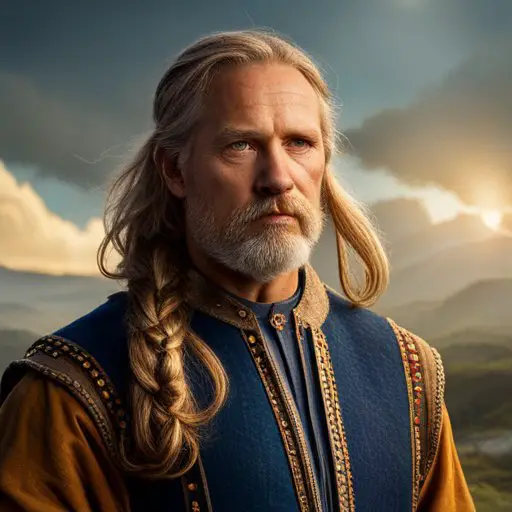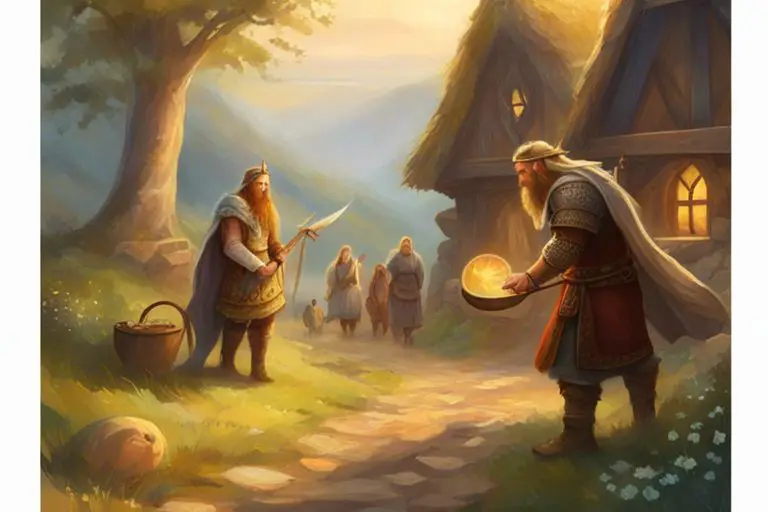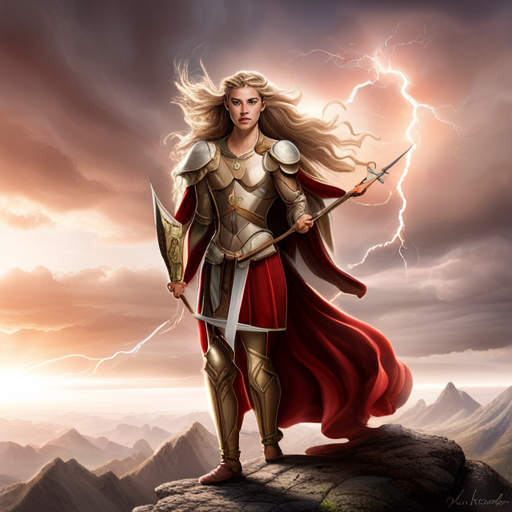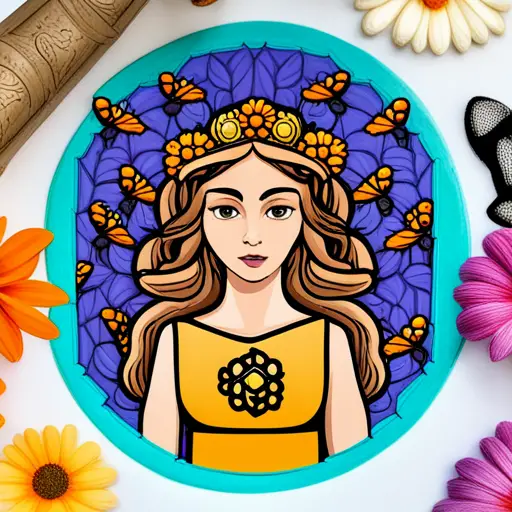It was a coincidence that led me down the path of discovering the history of Viking clothing and accessories.
While browsing through a thrift store, I stumbled upon a replica Viking helmet and was immediately drawn to its intricate detailing.
As I began to research the helmet, I found myself delving deeper into the world of Viking fashion and uncovering a rich and fascinating history.
Viking fashion is not just about the practicality of clothing and accessories, but also the symbolism and cultural significance behind them.
It is an important aspect of Norse culture that allows us to understand the values and beliefs of the Viking people.
As I traced the evolution of Viking fashion over time, I uncovered a story of resilience, creativity, and pride in one’s heritage.
Join me as we unveil the secrets of Norse fashion and discover the unique and captivating world of Viking clothing and accessories.
Materials and Textiles Used in Viking Clothing
The use of various materials and textiles was integral to creating the distinct style of the Viking wardrobe. The Vikings were known for their mastery of wool and linen, which were the most commonly used materials for clothing. In fact, the Vikings had a thriving wool industry, and it wasn’t uncommon for them to import fine linens and silks from other parts of the world.
Aside from wool and linen, the Vikings also used leather, fur, and even feathers in their clothing and accessories. Leather was used for shoes, belts, and armor, while fur was used for warmth in colder climates. Feathers were also used as decoration for hats and other accessories.
The combination of these materials and textiles created the unique look that we now associate with Viking fashion. Next, let’s take a look at the specific clothing and accessories that were worn by Viking men.
Men’s Clothing and Accessories
If you thought vikings only wore horned helmets, prepare to be surprised by the diverse and practical men’s clothing and accessories that they actually used.
Vikings were known for their sturdy and warm clothing that protected them from the harsh Nordic climates. They wore woolen tunics and trousers, which were often decorated with intricate embroidery and patterns. Fur was also a common material used for clothing, particularly for the colder months.
They also used leather for their shoes, boots, belts, and pouches. These accessories were not just fashionable, but also had practical uses, such as holding weapons and tools. Vikings also had a distinct hairstyle, where they grew their hair long and styled it in various ways, such as braids or top knots.
They also had a well-groomed beard, which they considered a symbol of masculinity. Jewelry was also an important part of Viking fashion, as they adorned themselves with various pieces made of silver, gold, and bronze. These pieces often had intricate designs and symbols, such as Thor’s hammer or Odin’s ravens.
Overall, Viking men’s clothing and accessories were not just functional but also reflected their culture, beliefs, and social status.
As we delve into the history of Viking fashion, it’s important to also explore the women’s clothing and accessories of that time.
Women’s Clothing and Accessories
Get ready to step into the shoes of a Viking woman and discover the hidden gems of their wardrobe, like unearthing a treasure chest full of secrets.
Viking women played a significant role in their society, and their clothing was an essential aspect of their identity. Like their male counterparts, Viking women wore woolen clothes, which were durable and warm. However, the difference between men’s and women’s clothing was in the details and accessories.
Viking women wore long dresses, usually with a belt at the waist. These dresses were often adorned with embroidery, which varied depending on the region, social status, and personal preference.
Viking women also wore shawls or cloaks to keep warm, and they often had a brooch to secure it in place. Jewelry was also an essential part of Viking women’s attire, and they wore items such as necklaces, bracelets, and rings. The jewelry often had intricate designs and was made of precious metals or stones.
Symbolism in Viking Fashion
As you explore Viking fashion, you’ll discover the rich symbolism behind the embroidery, jewelry, and other adornments worn by women, revealing a deeper understanding of their culture and beliefs. The intricate designs on their clothing and accessories were not just for aesthetic purposes, but also had significant meanings.
For instance, the Valknut symbol was believed to represent the connection between the three worlds of Norse mythology: Asgard (the world of the gods), Midgard (the world of humans), and Helheim (the world of the dead). This symbol was often embroidered onto clothing or worn as a pendant to invoke the protection of Odin, the god of war and death.
Another popular symbol in Viking fashion was the Mjolnir, the hammer of Thor, the god of thunder. This symbol represented strength, power, and protection, and was frequently depicted in jewelry worn by women. Additionally, the use of animal motifs, such as wolves or birds of prey, conveyed ideas of bravery, loyalty, and freedom.
By understanding the symbolism behind these designs, we can gain a deeper appreciation for the cultural values and beliefs of the Viking people.
As fashion continued to evolve throughout the Viking Age, we see changes in the styles and materials used in clothing and accessories. The early Viking period saw a reliance on wool and linen fabrics, while the later period saw an increase in imported silks and other luxurious materials. The use of silver and gold for jewelry also became more prevalent as Viking society became more prosperous.
Despite these changes, the rich symbolism and intricate designs remained an integral part of Viking fashion throughout its history.
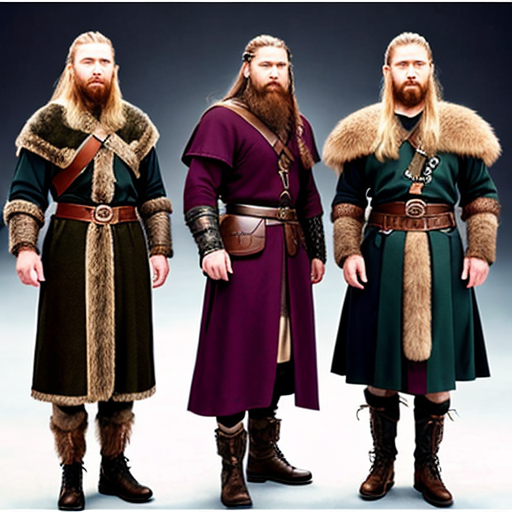
Evolution of Viking Fashion Over Time
You’re in for a treat as we take a journey through time and witness how the Viking fashion has transformed, leaving us awe-inspired at the creativity and ingenuity of the people.
The Viking fashion evolved over time, influenced by factors such as climate, social status, and the availability of resources. During the early Viking Age, clothing was simple and practical, made from wool or linen. However, as the Vikings began to expand their trade routes, they were exposed to new fabrics such as silk and cotton.
This led to the incorporation of new materials and designs into Viking fashion, resulting in more elaborate and decorative clothing. Additionally, the Vikings began to use dyes to add color to their garments, with red being a popular choice.
As the Viking Age progressed, clothing became more ornate and was used as a way to display wealth and social status. Jewelry, such as brooches and arm rings, also became more elaborate and were used as symbols of power.
Frequently Asked Questions
What was the average lifespan of a Viking garment?
The average lifespan of a Viking garment was relatively short due to the rough and rugged lifestyle of the Norse people. Most garments were made from natural materials like wool and linen, which were susceptible to wear and tear over time. Viking clothing was often exposed to the elements during long voyages at sea and battles on land, which further contributed to their quick deterioration.
Despite their short lifespan, however, Viking garments were intricately designed and often adorned with intricate patterns and symbols that spoke to the cultural identity of the Norse people.
Did Vikings use any natural dyes for their clothing?
To answer the question, yes, Vikings did use natural dyes for their clothing.
They used a variety of plants, berries, and minerals to create different colors, such as yellow from birch leaves, red from madder root, and blue from woad.
These natural dyes were readily available and were an important part of Viking culture and fashion. By using natural dyes, they were able to create unique and beautiful clothing that reflected their connection to the natural world.
Learning about the use of natural dyes in Viking clothing is not only fascinating but also gives us insight into the rich history of this ancient culture.
Were there any restrictions on certain colors or fabrics in Viking fashion?
Honestly, it’s surprising how free the Vikings were when it came to their fashion choices. There weren’t any strict rules or restrictions on certain colors or fabrics.
They used whatever was available to them, whether it was wool or linen, and they often dyed their fabrics with natural dyes from plants like madder or woad.
It’s fascinating to think how much creativity and individuality there must have been in Viking fashion, especially considering their reputation for being fierce warriors. But then again, maybe that’s why they were so successful – because they were able to express themselves freely and confidently through their clothing.
When it comes to Viking clothing, there was a clear distinction between the clothing worn by different social classes. The higher classes wore more elaborate clothing made out of finer materials such as silk, linen, and wool. They also had access to more intricate designs and decorative elements such as fur and embroidery.
In contrast, lower-class individuals wore simpler clothing made from less expensive materials like coarse wool or linen. It’s fascinating to see how clothing can reflect social status, but it’s also important to remember that clothing was not the only indicator of social class in Viking society.
Were there any specific rituals or ceremonies associated with the creation or wearing of Viking clothing?
There were indeed specific rituals and ceremonies associated with the creation and wearing of Viking clothing.
As a culture deeply rooted in paganism, the Norse people believed that clothing had a spiritual significance. Clothing was often embroidered with symbols that represented the wearer’s connection to the gods and the natural world.
Additionally, certain garments, such as cloaks or arm rings, were given as gifts during important ceremonies like weddings or funerals. These items were considered sacred and were believed to have protective powers.
As someone interested in Viking fashion, I find it fascinating how deeply intertwined clothing was with Norse beliefs and traditions.
Conclusion
In conclusion, delving into the history of Viking clothing and accessories has been an eye-opening and enriching experience. The intricate details and symbolism in each garment and accessory reveal a great deal about the Norse culture and way of life.
It’s fascinating to see how the use of materials and textiles evolved over time, from animal hides and wool to silk and embroidery. However, juxtaposed with this admiration for Viking fashion is the reality of their violent and oppressive actions towards other cultures.
It’s important to acknowledge and address the dark side of history while also appreciating and learning from the positive aspects. Overall, tracing Viking fashion history has been a reminder of the complexity of human civilization and the importance of understanding and respecting diverse cultures.

